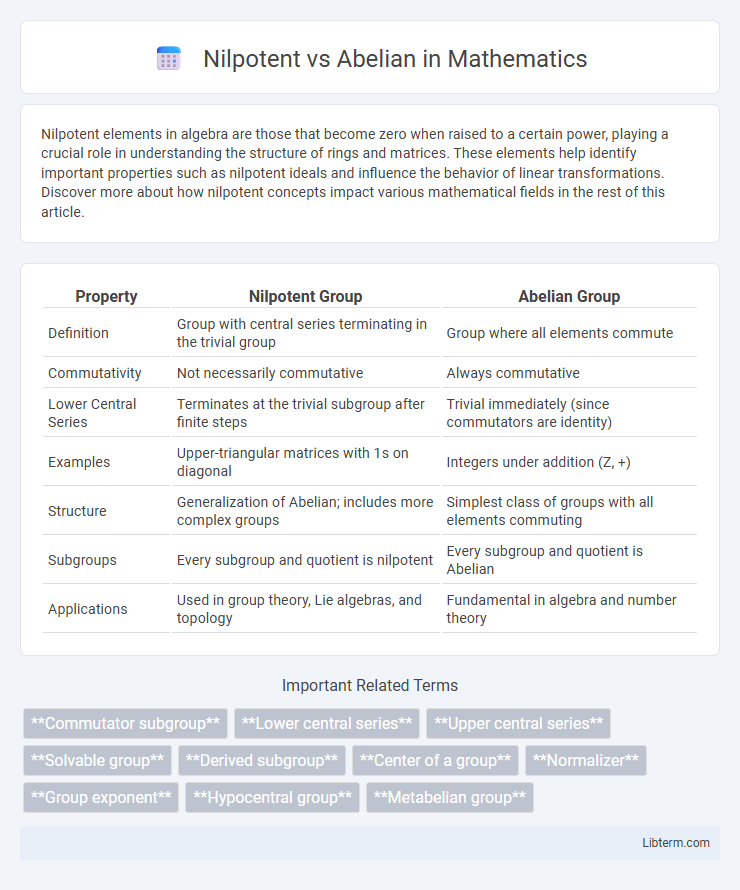Nilpotent elements in algebra are those that become zero when raised to a certain power, playing a crucial role in understanding the structure of rings and matrices. These elements help identify important properties such as nilpotent ideals and influence the behavior of linear transformations. Discover more about how nilpotent concepts impact various mathematical fields in the rest of this article.
Table of Comparison
| Property | Nilpotent Group | Abelian Group |
|---|---|---|
| Definition | Group with central series terminating in the trivial group | Group where all elements commute |
| Commutativity | Not necessarily commutative | Always commutative |
| Lower Central Series | Terminates at the trivial subgroup after finite steps | Trivial immediately (since commutators are identity) |
| Examples | Upper-triangular matrices with 1s on diagonal | Integers under addition (Z, +) |
| Structure | Generalization of Abelian; includes more complex groups | Simplest class of groups with all elements commuting |
| Subgroups | Every subgroup and quotient is nilpotent | Every subgroup and quotient is Abelian |
| Applications | Used in group theory, Lie algebras, and topology | Fundamental in algebra and number theory |
Introduction to Nilpotent and Abelian Groups
Nilpotent groups are characterized by a central series where each quotient is contained in the center of the group, leading to a hierarchical structure that generalizes abelian groups. Abelian groups represent the simplest form where the group operation is commutative, meaning every pair of elements commutes. Understanding nilpotent groups involves exploring their stepwise commutativity, which extends beyond the fully commutative nature of abelian groups.
Defining Nilpotent Groups
Nilpotent groups are algebraic structures characterized by a central series terminating in the trivial subgroup, ensuring every element commutes within successive centers. Unlike Abelian groups, where all elements commute universally, nilpotent groups generalize this concept by allowing non-commuting elements controlled through their lower central series. This definition highlights the hierarchical commutativity in nilpotent groups, distinguishing them from the strictly commutative nature of Abelian groups.
Understanding Abelian Groups
Abelian groups are algebraic structures where the group operation is commutative, meaning for any elements a and b, the equation a * b = b * a holds. Understanding Abelian groups involves recognizing their simplicity compared to nilpotent groups, as every Abelian group is nilpotent but not all nilpotent groups are Abelian. Key properties of Abelian groups include the ability to be decomposed into direct sums of cyclic groups, which facilitates analysis in various fields such as number theory and algebraic topology.
Key Differences Between Nilpotent and Abelian Groups
Nilpotent groups have a central series terminating in the trivial subgroup, indicating a hierarchical structure of normal subgroups, whereas Abelian groups require only commutativity of group elements. Every Abelian group is nilpotent, but not every nilpotent group is Abelian, highlighting that nilpotency is a broader property encompassing controlled non-commutativity. The key difference lies in the commutator subgroup behavior: Abelian groups have a trivial commutator subgroup, while nilpotent groups possess a nontrivial upper central series that eventually becomes trivial.
Structural Properties of Nilpotent Groups
Nilpotent groups exhibit a central series terminating in the trivial subgroup, making their structure highly hierarchical and decomposable into simpler normal subgroups. Unlike Abelian groups, where commutativity is global, nilpotent groups maintain a stepwise commutativity through their upper central series, reflecting deeper layers of commutator control. This layered centralization results in a profound influence on their subgroup structure, automorphisms, and representation theory.
Structural Properties of Abelian Groups
Abelian groups are characterized by their commutative property, meaning the group operation satisfies \( ab = ba \) for all elements \( a, b \). Structurally, every finitely generated abelian group decomposes into a direct sum of cyclic groups, reflecting its well-understood classification theorem. In contrast, nilpotent groups possess a central series whose successive quotients lie in the center, highlighting a hierarchical structure that generalizes abelian groups but lacks their full commutativity.
Examples of Nilpotent vs Abelian Groups
Nilpotent groups include examples like the Heisenberg group over integers and p-groups such as the group of upper triangular matrices with ones on the diagonal. Abelian groups are commutative, with examples including the additive group of integers \(\mathbb{Z}\) and vector spaces over fields, which are Abelian under vector addition. Every Abelian group is nilpotent with nilpotency class 1, but nilpotent groups can be non-Abelian and exhibit more complex commutator patterns.
Subgroup Behavior in Nilpotent and Abelian Groups
Nilpotent groups exhibit a highly structured subgroup behavior where every subgroup is subnormal and the upper central series terminates at the group itself, ensuring a rich hierarchy of normal subgroups. In contrast, Abelian groups have all subgroups normal due to commutativity, but their subgroup lattice is simpler without the deeper central series found in nilpotent groups. The key distinction lies in nilpotent groups allowing non-commutative behavior with controlled subgroup normality, whereas Abelian groups maintain universal commutativity and simpler subgroup dynamics.
Applications in Algebra and Beyond
Nilpotent groups find critical applications in the classification of finite p-groups and play a vital role in algebraic topology, particularly in homotopy theory through their connection with lower central series and central extensions. Abelian groups form the foundation of modules over rings, enabling the study of linear algebra, homological algebra, and algebraic geometry, where their structure simplifies many complex proofs. Beyond pure algebra, nilpotent Lie groups are essential in theoretical physics for symmetry analysis, while abelian groups underpin cryptographic systems and coding theory due to their well-understood and computationally efficient structures.
Summary: Choosing Nilpotent or Abelian Structures
Nilpotent structures feature a hierarchical commutator relation yielding strong constraints and a well-defined lower central series, making them ideal for analyzing complex group actions and stepwise decompositions. Abelian structures exhibit complete commutativity, simplifying calculations and enabling straightforward applications in linear algebra, module theory, and topology. Selecting between nilpotent and abelian groups depends on the desired balance of structural complexity versus algebraic simplicity for specific mathematical or physical models.
Nilpotent Infographic

 libterm.com
libterm.com